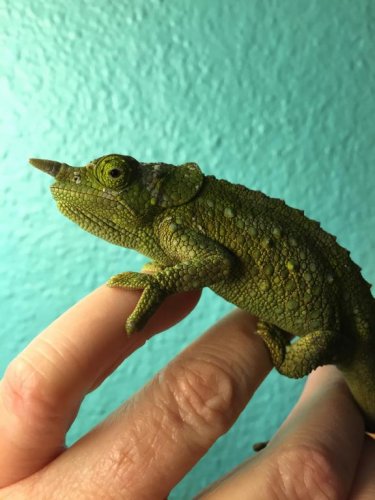Navigation
Install the app
How to install the app on iOS
Follow along with the video below to see how to install our site as a web app on your home screen.
Note: This feature may not be available in some browsers.
More options
You are using an out of date browser. It may not display this or other websites correctly.
You should upgrade or use an alternative browser.
You should upgrade or use an alternative browser.
Breeding werners
- Thread starter Hiller
- Start date
LetmegrowSTL
New Member
They are pretty much like a Jackson's, if you are familiar. The questions is how fast do you want to burn the female out?
The male will breed, no matter the "season". The female needs to recoup after having a litter, that could be a few weeks if you are trying to produce many babies quickly, the more caring/humane way is to give her a few months and fatten back up before you let them go at it. You should keep them separated after a successful copulation.
The male will breed, no matter the "season". The female needs to recoup after having a litter, that could be a few weeks if you are trying to produce many babies quickly, the more caring/humane way is to give her a few months and fatten back up before you let them go at it. You should keep them separated after a successful copulation.
Yes sorry I think that came across wrong..... I like to keep my animals in top shape and give all my female breeders breaks. I would like to get babies cause it's a great feeling of accomplishment but not at the expense of my female. I am unfortunately not familiar with the breeding of Jackson's.
Trace
Captain Awesome
Well mine only bred once a year usually early in the year (Jan-March) when the days started to become a little longer. I try and mimic the weather conditions in their native Tanzania, as opposed to the usual husbandry techniques that are parroted by people here and on social media, so my animals behaved a little differently. Some of these weirder species do come from some extreme conditions and areas my thoughts are they need to replicated in captivity for them to survive and thrive.
I’ve written a blog about it, that really needs to be updated and expanded upon but perhaps you can find some help in here: https://www.chameleonforums.com/blogs/trace/780-random-musings-seasonal-cycling.html
It’s my experience only and there are others that have bred the Trioceros werneri on this board that may have different know-how.
I’ve written a blog about it, that really needs to be updated and expanded upon but perhaps you can find some help in here: https://www.chameleonforums.com/blogs/trace/780-random-musings-seasonal-cycling.html
It’s my experience only and there are others that have bred the Trioceros werneri on this board that may have different know-how.
CarlC
Established Member
As Trace stated seasonal replication is a must for certain species and werneri is one of those species. Seasonal variation involves temperature and rainfall. It should also be noted that this variation is needed for the longterm health of the animals.
Both of my werneri pairs bred in March. At breeding time both females were already gravid so this species is capable to taking and holding sperm. The females gave birth at the end of August to the clutch's they were already carrying.
Now a year after breeding here both females are huge and should be dropping their clutch's soon.
There appears to be two birthing seasons each year depending on the age of the female when she is bred. Virgin females bred for the first time drop their clutch's later in the year while older females who have previously produced drop their clutch's earlier in the year.
Carl
Both of my werneri pairs bred in March. At breeding time both females were already gravid so this species is capable to taking and holding sperm. The females gave birth at the end of August to the clutch's they were already carrying.
Now a year after breeding here both females are huge and should be dropping their clutch's soon.
There appears to be two birthing seasons each year depending on the age of the female when she is bred. Virgin females bred for the first time drop their clutch's later in the year while older females who have previously produced drop their clutch's earlier in the year.
Carl
Thanks a bunch guys! They are at home doing great and the female is defiantly gravid. So Carl are you saying I should try breeding her now for the next breeding or wait. I don't want to over breed and I don't want to stress her out when she is gravid. Again I am new with these guys. I do have a mellers so I know it's basically the same housing conditions just in a smaller scale but I only know about breeding panthers.
Trace
Captain Awesome
It really depends on the time of year and the personalities of the individuals. Sometimes the gravid females get stressed out by the close proximity of the males so adding a barricade was needed. Some females didn’t care. Some males will constantly display to the ladies if they see them; some not. Use your discretion. If you would rather not take chances or if you think you might miss some of the signs, then a simple sightline barrier between cages will not hurt.
CarlC
Established Member
You won't over breed them. They only drop a single clutch each year.
I've only kept them separate. My males are relentless with trying to breed. The only way I knew my females were receptive was they became very active climbing the cage walls.
Try showing the male to the female. You will know very quick if she is ready.

Carl
I've only kept them separate. My males are relentless with trying to breed. The only way I knew my females were receptive was they became very active climbing the cage walls.
Try showing the male to the female. You will know very quick if she is ready.

Carl






